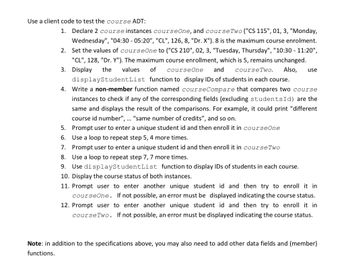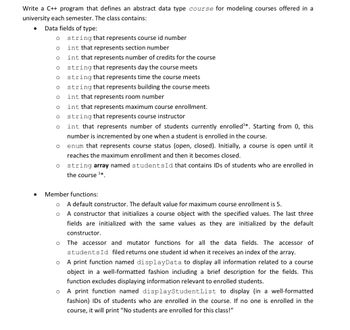
Computer Networking: A Top-Down Approach (7th Edition)
7th Edition
ISBN: 9780133594140
Author: James Kurose, Keith Ross
Publisher: PEARSON
expand_more
expand_more
format_list_bulleted
Question
Please try using Occam’s razor principle if possible.

Transcribed Image Text:Use a client code to test the course ADT:
1. Declare 2 course instances courseOne, and course Two ("CS 115", 01, 3, "Monday,
Wednesday", "04:30 - 05:20", "CL", 126, 8, "Dr. X"). 8 is the maximum course enrolment.
2. Set the values of courseOne to ("CS 210", 02, 3, "Tuesday, Thursday", "10:30 - 11:20",
"CL", 128, "Dr. Y"). The maximum course enrollment, which is 5, remains unchanged.
3. Display the values of courseOne and courseTwo. Also, use
displayStudentList function to display IDs of students in each course.
4. Write a non-member function named courseCompare that compares two course
instances to check if any of the corresponding fields (excluding studentsId) are the
same and displays the result of the comparisons. For example, it could print "different
course id number", ... "same number of credits", and so on.
5. Prompt user to enter a unique student id and then enroll it in courseOne
6.
Use a loop to repeat step 5, 4 more times.
7. Prompt user to enter a unique student id and then enroll it in course Two
8. Use a loop to repeat step 7, 7 more times.
9. Use displayStudentList function to display IDs of students in each course.
10. Display the course status of both instances.
11. Prompt user to enter another unique student id and then try to enroll it in
courseOne. If not possible, an error must be displayed indicating the course status.
12. Prompt user to enter another unique student id and then try to enroll it in
course Two. If not possible, an error must be displayed indicating the course status.
Note: in addition to the specifications above, you may also need to add other data fields and (member)
functions.

Transcribed Image Text:Write a C++ program that defines an abstract data type course for modeling courses offered in a
university each semester. The class contains:
Data fields of type:
O
O
O
O
O
O
O
O
O
O
O
O
O
O
string that represents course id number
int that represents section number
int that represents number of credits for the course
string that represents day the course meets
string that represents time the course meets.
string that represents building the course meets
int that represents room number
int that represents maximum course enrollment.
Member functions:
O
string that represents course instructor
int that represents number of students currently enrolled¹*. Starting from 0, this
number is incremented by one when a student is enrolled in the course.
enum that represents course status (open, closed). Initially, a course is open until it
reaches the maximum enrollment and then it becomes closed.
string array named students Id that contains IDs of students who are enrolled in
the course ¹*
A default constructor. The default value for maximum course enrollment is 5.
A constructor that initializes a course object with the specified values. The last three
fields are initialized with the same values as they are initialized by the default
constructor.
The accessor and mutator functions for all the data fields. The accessor of
students Id filed returns one student id when it receives an index of the array.
O
A print function named displayData to display all information related to a course
object in a well-formatted fashion including a brief description for the fields. This
function excludes displaying information relevant to enrolled students.
O
A print function named displayStudent List to display (in a well-formatted
fashion) IDs of students who are enrolled in the course. If no one is enrolled in the
course, it will print "No students are enrolled for this class!"
Expert Solution
This question has been solved!
Explore an expertly crafted, step-by-step solution for a thorough understanding of key concepts.
Step by stepSolved in 2 steps

Knowledge Booster
Similar questions
- Explain the concept of integer factorization and its importance in public-key cryptography (e.g., RSA).arrow_forwardIce is a good example of translucency. True Falsearrow_forwardDecrypt this Rotational (ROT) Cipher. Write your answer in ALL CAPS. (Hint: The shift is +53 or -53) OBQ UJNFarrow_forward
- Please help me quicklyarrow_forwardDescribe the steps involved in mounting a statistical attack on a monoalphabetic substitution cipher. (please do not explain it with pictures) Explain why this approach would fail on a polyalphabetic substitution cipher?arrow_forwardIn this article, we will look at two of the most used fingerprinting algorithms.arrow_forward
- In my opinion, there is not much of a distinction to be made between the two varieties of cryptography.arrow_forwardPut the correct answer?arrow_forwardPerform encryption and decryption using the RSA algorithm for the following. Show allyour steps.1. p = 3; q = 11, e = 7; M = 52. p = 5; q = 11, e = 3; M = 9arrow_forward
arrow_back_ios
SEE MORE QUESTIONS
arrow_forward_ios
Recommended textbooks for you
 Computer Networking: A Top-Down Approach (7th Edi...Computer EngineeringISBN:9780133594140Author:James Kurose, Keith RossPublisher:PEARSON
Computer Networking: A Top-Down Approach (7th Edi...Computer EngineeringISBN:9780133594140Author:James Kurose, Keith RossPublisher:PEARSON Computer Organization and Design MIPS Edition, Fi...Computer EngineeringISBN:9780124077263Author:David A. Patterson, John L. HennessyPublisher:Elsevier Science
Computer Organization and Design MIPS Edition, Fi...Computer EngineeringISBN:9780124077263Author:David A. Patterson, John L. HennessyPublisher:Elsevier Science Network+ Guide to Networks (MindTap Course List)Computer EngineeringISBN:9781337569330Author:Jill West, Tamara Dean, Jean AndrewsPublisher:Cengage Learning
Network+ Guide to Networks (MindTap Course List)Computer EngineeringISBN:9781337569330Author:Jill West, Tamara Dean, Jean AndrewsPublisher:Cengage Learning Concepts of Database ManagementComputer EngineeringISBN:9781337093422Author:Joy L. Starks, Philip J. Pratt, Mary Z. LastPublisher:Cengage Learning
Concepts of Database ManagementComputer EngineeringISBN:9781337093422Author:Joy L. Starks, Philip J. Pratt, Mary Z. LastPublisher:Cengage Learning Prelude to ProgrammingComputer EngineeringISBN:9780133750423Author:VENIT, StewartPublisher:Pearson Education
Prelude to ProgrammingComputer EngineeringISBN:9780133750423Author:VENIT, StewartPublisher:Pearson Education Sc Business Data Communications and Networking, T...Computer EngineeringISBN:9781119368830Author:FITZGERALDPublisher:WILEY
Sc Business Data Communications and Networking, T...Computer EngineeringISBN:9781119368830Author:FITZGERALDPublisher:WILEY

Computer Networking: A Top-Down Approach (7th Edi...
Computer Engineering
ISBN:9780133594140
Author:James Kurose, Keith Ross
Publisher:PEARSON

Computer Organization and Design MIPS Edition, Fi...
Computer Engineering
ISBN:9780124077263
Author:David A. Patterson, John L. Hennessy
Publisher:Elsevier Science

Network+ Guide to Networks (MindTap Course List)
Computer Engineering
ISBN:9781337569330
Author:Jill West, Tamara Dean, Jean Andrews
Publisher:Cengage Learning

Concepts of Database Management
Computer Engineering
ISBN:9781337093422
Author:Joy L. Starks, Philip J. Pratt, Mary Z. Last
Publisher:Cengage Learning

Prelude to Programming
Computer Engineering
ISBN:9780133750423
Author:VENIT, Stewart
Publisher:Pearson Education

Sc Business Data Communications and Networking, T...
Computer Engineering
ISBN:9781119368830
Author:FITZGERALD
Publisher:WILEY